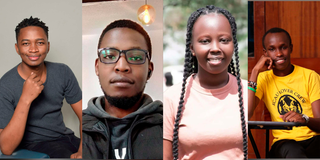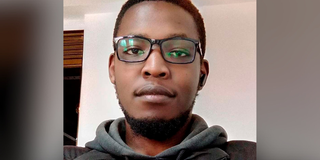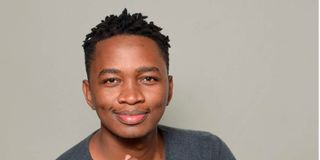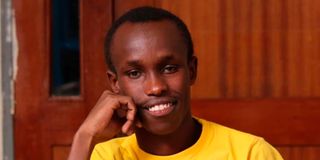
(From left) Freelancers Mark Mumangi, Kevin Sande, Eddah Waithaka and Wessley Kiringu.
Picture this: It's 11 AM on a Wednesday, and Sarah Maigwa, 24, is wrapping up a client call from a sun-drenched café in Lamu.
Three years ago, she would have been trapped in a fluorescent-lit cubicle, counting minutes until lunch.
Today, she's part of a growing revolution where Gen Z is rewriting the rules of work—and the traditional 9-to-5 isn't making the cut.
The corporate ladder? Gen Z is building their own elevator. As the first truly digital native generation enters the workforce, they're rejecting conventional career paths in favour of something more aligned with their values: freedom, flexibility, and the power to craft their own professional narrative.
The numbers tell a compelling story. Upwork's latest data reveals that over half of Gen Z freelancers are putting in full-time hours across diverse projects, with a third having mastered this independent lifestyle for more than two years. But this isn't just about working remotely—it's about working differently.
Think of it as career choose-your-own-adventure. Want to design websites at midnight? Code from a mountain cabin? Write marketing copy between hiking sessions? For Gen Z, freelancing isn't just a job choice—it's a lifestyle revolution that prioritises autonomy over hierarchy, meaning over monotony.
Yet this freedom comes with its own fine print. The feast-or-famine cycle of project work, the absence of traditional benefits, and the constant hustle for new clients create a different kind of pressure. It's a trade-off that requires sharp business acumen, ironclad discipline, and a tolerance for uncertainty that would make most traditional employees nervous.
In this week's deep dive for MyNetwork, we meet the bold young professionals who've torn up the traditional career playbook to write their own success stories. Their journeys reveal why for many in Gen Z, the future of work looks nothing like the past—and that might be exactly the point.
I wanted to grow
Alexander Kiruga
One of the individuals thriving in the freelance space is Alexander Kiruga, 26, the director at Zander Worldwide Studios.
His company specialises in public relations, digital marketing, AI integration, and social media management. Speaking to MyNetwork, Alexander reflected on his transition from the traditional employment structure, offering insight into the mindset that led him to leave a full-time job.

Alexander Kiruga, 26, is the director of Zander Worldwide Studios, specialising in PR, digital marketing, AI integration, and social media management.
“Working a nine-to-five job made me feel limited, like I wasn't growing. Fatigue became a common issue, and it didn’t reflect in my personal development,” Kiruga explained.
For him, the rigid structure of office hours stifled his potential. He began freelancing by taking on small projects alongside his full-time job, but it quickly became clear that balancing both wasn’t sustainable.
“Pressure at work made it tough to deliver for my own clients, which eventually motivated me to quit and dive into freelancing fully,” he added.
The early stages of freelancing presented significant challenges for Kiruga. “Starting from scratch as a freelancer was hard,” he admitted. “I had to find mentors to guide me, especially during those months when jobs were scarce.
Financial planning, including taxes, savings, and accounting for emergencies, has been essential to managing the unpredictability of freelance income.” His experience shows that being a freelancer requires more than just skill—it demands a solid understanding of financial management and a willingness to learn from others.
On the issue of setting rates for his services, Kiruga shared a clear perspective: “Any business works on demand and supply. When the demand is high, we adjust our rates accordingly, but we also offer discounted rates to our loyal clients. Building trust and good relationships with clients has helped us grow—recommendations from existing clients are invaluable.” This emphasis on customer relationships underscores how freelancing isn’t just about delivering a service; it's about nurturing lasting connections that fuel future growth.
My mental health was affected
John Kamau, 25
John Kamau, 25, CEO of Gumbosky Media, also made the switch to freelancing after experiencing burnout in his previous 8-to-5 job at a marketing agency in Nairobi.
“I realised I was doing all the work in my department, and my mental health was suffering. That’s when I knew employment wasn’t for me,” Kamau revealed.

John Kamau, 25, CEO of Gumbosky Media, made the leap to full-time freelancing after burnout in his marketing job.
His decision was driven by the overwhelming workload that left him feeling emotionally drained, signaling that a change was necessary.
While working at the agency, Kamau handled social media marketing, email campaigns, and advertising, often juggling additional freelance clients on the weekends.
“There were days I’d work through the weekend, only to report to my full-time job on Monday feeling drained,” he recalled. As burnout loomed, Kamau made the choice to fully commit to freelancing.
Like many freelancers, Kamau faced financial struggles when starting out. “Sometimes I would get paid and spend everything, not considering the next gig or bill,” he admitted. However, over time, he learned the importance of savings and financial diversification.
“Apart from social media marketing, I also work as an emcee and photographer. These side gigs provide financial stability during slower freelance months.”
His approach highlights the need for adaptability in freelancing, where multiple streams of income can act as a buffer during dry spells.
Kamau stressed the importance of financial discipline for freelancers, emphasising how crucial it is to manage money wisely. “Savings are essential.
When you get paid, think of the money as not fully yours to spend—it’s for future needs, like rent or electricity. You need to be prepared for dry spells,” he advised.
His experience serves as a valuable lesson for freelancers who might be tempted to splurge after a big paycheck, only to find themselves scrambling when the next job doesn’t arrive on time.
As Kiruga aptly puts it, “Freelancing requires risk-taking, sacrifice, and dedication. You don’t just wake up and decide to go for it without a plan. You need to be ready for plans that don’t work out. That’s why we plan, and we have backup plans because this journey is unpredictable.”
The volatility of freelancing is part of what makes it both thrilling and daunting—but for those like Kiruga and Kamau, the rewards far outweigh the risks.
I desired freedom over my creativity
Kevin Sande, 26
Kevin Sande, 26, is a freelance designer who has embraced the world of freelancing with a keen focus on both creative freedom and the challenges that come with it.
Kevin shared that the main motivator for him to pursue freelancing was the desire for freedom.
“What motivated me to get into freelancing was mainly the freedom, the freedom to choose what I get to put my creative effort into," he said.

Kevin Sande, 26, is a freelance designer who values the creative freedom freelancing offers.
"I came to the realisation that in as much as working on a 9-to-5 is stable, it doesn’t give me the freedom to control what type of work I get. And you would find on several occasions, I end up working on projects which I either don’t like or I don’t enjoy, which can get draining after a while.”
For Kevin, freelancing was a way to regain control over his creative work. “Freelancing was kind of like trying to take back the control over what I pour myself into.
Because I do believe as a designer, as a creative, my work is a reflection of how I feel when I do the work. So, if I don’t enjoy the work, I won’t output good work,” he explained.
He also addressed the challenges of balancing his full-time job and freelancing.
“It’s not easy, given the time constraints that I have. During the day, I have my full-time job, and after that, that’s when I get onto my freelance stuff,” he said. To manage both, Kevin limits his freelance gigs to after-work hours. “Limiting my freelance gigs to after-work hours has kind of helped me balance both sides of the world,” he shared.
Kevin's journey into freelancing started on platforms like Fiverr, where he could connect with clients and offer his services.
“Fiverr is basically a platform where businesses or people looking for design services, they go there, look at the jobs people have posted, and then you find a client, or a client finds you,” he recalled. Since then, Kevin has expanded into other platforms like Contra, particularly as they gain traction in the African market.
As a graphic designer, Kevin specialises in brand design, helping businesses establish cohesive brand identities. His services include logo design, social media design, and marketing collateral.
“What I do is help businesses build out a cohesive brand identity by offering services like logo design, social media design, flyers, posters, and basically anything that goes toward building a business’s image,” he said.
The challenges of balancing both jobs are not without their hurdles. Time constraints are a significant issue for Kevin, especially with the creative demands of both his full-time job and freelance work.
“The challenge is the time constraint, because that is a key thing. Also, the job opportunities as a freelancer don't come by as consistently as you'd think compared to a full-time job,” he explained. Sometimes, he faces periods of high demand, while at other times, freelance work can be scarce.
One of the hardest parts of balancing both worlds is managing his energy. “I spend the day from 8 to 5 working, and work contains creative things. Some days, I have a freelance gig after work, and I have totally drained all my creative juices during the day. So trying to find a balance between delivering my best for both the freelance and full-time job is challenging,” he admitted.
For Kevin, key skills like clear communication and time management have been essential in managing both responsibilities. “One skill that has helped me is communication.
I try and keep communication lines between me and the people I work with very open,” he said. By keeping clients updated on the progress of their projects, Kevin ensures they have realistic expectations regarding timelines.
He also manages his time by prioritising tasks based on urgency. “I allocate my time and my energy based off the urgency of the brief,” he shared.
Looking to the future, Kevin hopes to transition to full-time freelancing once it becomes financially stable enough. “I do see myself transitioning to full-time freelance in the future.
It’s actually a goal for me. Getting to the point where I can proudly say I don’t need to be employed by anyone else,” he said, acknowledging that the transition will be gradual. He plans to wait until his freelance revenue can fully support his basic needs before making the leap.
“Gen Z’s approach to freelancing is different from previous generations because it has taken on a more online, remote structure. Freelancers nowadays can work from anywhere in the world. It doesn’t matter where you are, as long as you can get the job done,” he observed.
He also noted that Gen Z freelancers are motivated by fulfilment rather than just financial gain. “For Gen Zs, it’s more about how can I get more fulfilment out of this? The previous generations were more focused on making money,” he concluded.
Unreliable salary payments
Mark Mumangi, 26
Mark Mumangi transitioned to full-time freelancing after years of working on freelance projects while juggling various jobs.
“I started my career as a freelance graphic designer in 2017, using Android apps to make logos and picture quotes. I eventually moved on to making posters for school clubs and Christian organisations, getting paid about Sh500 for two posters for a church. That meant a lot to me at the time,” Mark said, reflecting on his early experiences.

Mark Mumangi, 26, a brand designer and educator, made the leap to full-time freelancing after years of balancing various jobs.
He noted that his passion for visual design took off after a friend gifted him a laptop:
"Learning Adobe Photoshop was a game-changer for me. I got into photo retouching, manipulation, and poster design, which opened doors to bigger projects."
Mark’s transition from traditional employment to freelancing wasn’t smooth. After working at a printing shop with a demanding schedule of 7 am to 6 pm, he found it difficult to manage his freelance work alongside the full-time job.
“I was often stretched thin, working late into the night to finish freelance projects after my long workdays. Eventually, I had to put most of my freelance projects on hold. The printing job was also unreliable when it came to payments, which added stress to an already tough situation,” Mark explained.
After weighing his options, he made the decision to leave and pursue freelancing full-time.
Financial challenges
Freelancing came with financial challenges, especially during slow periods.
“After leaving the printing job, I faced financial instability. I was broke 90 percent of the time,” he admitted.
To cope, Mark implemented a basic budgeting system, “I track my expenses carefully and avoid overspending during good months. I even created an Excel sheet to outline my essentials and ensure I only spend on what’s necessary,” he said.
Mark also shared his approach to structuring finances:
“I set aside portions of my income for bills and savings right after receiving payments from clients. I don’t follow a fixed percentage, as payments vary, but I adjust my budget depending on what I make.”
Setting fair rates as a freelancer can be challenging, but Mark has learned how to navigate the market.
“When I started, I charged Sh600 for a logo, but my skills didn’t justify higher rates. Over time, as my expertise grew, so did my prices,” he shared. He learned from a fellow creative that, “When too many people are saying yes to your rates, it’s time to raise them.”
Freelancing success relies heavily on networking and client acquisition.
“I post regularly on Instagram, Facebook, TikTok, X, and LinkedIn. TikTok is especially great for sharing process videos and personal stories,” he said. He also runs ads on Facebook and Instagram, sends out newsletters through his platform ‘Creative Bytes’ (which has over 1,200 subscribers), and gets many clients through referrals.
“Referrals from friends and past clients have been invaluable,” he noted.
Managing a work-life balance can be challenging, especially when working from home or with flexible hours. Mark has tried to set boundaries, but often finds himself making exceptions when client work demands extra effort.
“Recently, I collaborated with a friend to create a centerpiece artwork for one of the best publishing companies in Africa. We worked late nights and sacrificed personal time, but the result was worth it. The company won an award for the best thematic interpretation at the Nairobi Bookfair,” he recounted.
To ensure the sustainability of his freelancing career, Mark invests in continuous learning:
“As the industry evolves, I have to evolve with it. Currently, I’m taking Google’s UX design certificate to polish my UI/UX skills,” he said. Investing in professional courses and upgrading his skills has been key to his growth and adaptability in the competitive freelance market.
Tapping into the market
Mwaniki Kariuki, 23
Freelancing, especially in the creative industry, can be both rewarding and challenging. Mwaniki Kariuki a freelance graphic designer, transitioned to full-time freelancing after realising the growing demand for graphic design services.
“I got into freelancing because I realised there was a high demand for graphic design services, which I knew I could handle,” he says. “I knew the time was ripe to quit my 9-5 when I realised that I could earn twice through freelancing what I earned from full-time employment.”

Mwaniki Kariuki, 23, a freelance graphic designer, switched to full-time freelancing after earning more than his 9-5 job.
Before making the leap, Mwaniki had been juggling small freelance projects alongside his full-time job.
“Working on the projects was a bit challenging,” he admits. “I had to use the desktop at my workplace, which didn’t always sit well with management. After 5pm, I would borrow a laptop from friends to complete the tasks I got during the day.”
But making the shift came with its share of challenges. “One of the biggest hurdles was unreliable network connections, which made it difficult to do research.
On top of that, I didn’t have an up-to-date laptop capable of handling large projects like designing a 2m by 1m banner, so I had to borrow from friends,” he explains. Additionally, power outages in his area slowed down his workflow, leaving him frustrated at times.
To manage the unpredictable nature of freelance income, Mwaniki says he’s signed contracts with several clients, ensuring a steady stream of work.
“I’m assured of a payout weekly, which is enough to cater to my bills,” he adds. He also follows a structured approach to his finances, ensuring he saves at least 20 per cent of his earnings on a weekly basis.
When determining his rates, Mwaniki evaluates each project individually, based on its scope and the client’s budget. “For instance, I charge Sh800 for a normal poster, but I’ll add Sh500 if I need to edit the layout,” he notes.
Networking has played a critical role in his freelancing success. “Social networking is so important for anyone wanting to get into freelancing.
You meet potential clients who later become returning ones. Plus, I always get referrals from my clients, and sending out proposals to potential clients has worked well for me.”
Mwaniki has found his niche in graphic design, specialising in corporate, club, entertainment, food, and social media designs. As for work-life balance, he has developed a flexible schedule that works for him. “I work from 9am to 2pm, rest until 6pm, and then work from 6pm until 4am. The 6pm to 4am window is usually the most productive time for me as a creative.”
To ensure the long-term sustainability of his freelancing career, Mwaniki focuses on securing contracts with clients who need regular designs, such as DJs and club owners.
However, like many freelancers, he has faced challenges managing health insurance and retirement planning. “I used to pay Sh500 monthly for NHIF, but now, with SHA, I’m not sure how to proceed. I don’t have a retirement plan subscription either.”
For those considering full-time freelancing, Mwaniki advises that having the right skills is crucial.
“Ensure you have a reliable network provider, a good workstation, and a laptop with at least 8GB RAM and 256GB ROM. If you’re a photographer or videographer, you don’t need to own a camera starting out; you can hire one when needed or work as an assistant.”
Reflecting on his journey, Mwaniki wishes he had known more about networking with colleagues early on. “Learning from others in the field would have helped me grow faster,” he concludes, a sentiment that echoes the importance of building strong connections in any freelancing career.
Lack of options
Eddah Waithaka, 25
For Eddah Waithaka her freelancing motivation came at a later stage due to a lack of options after graduation.
“Motivation came at a later stage because I did not have any option. After my graduation in 2023 from Maasai Mara Univerity with a degree in Kiswahili and Media, I tried applying for jobs and was not successful in any. Therefore, I resorted to becoming a full-time freelancer,” she says.

Eddah Waithaka, 25, a freelance writer and photographer, transitioned to full-time freelancing after graduation in 2023.
Despite the challenge, Eddah embraced freelancing because she couldn’t stay at home after graduation.
Her internship at a local newsroom had already equipped her with freelancing skills, making the transition smoother.
“During my internship, I had already learned how to freelance through other journalists, so it was easy to transition to freelance photography," she shares.
Although she had taken on small freelance projects while interning, she explains that managing both the internship and freelance work wasn’t difficult.
“What I was doing in my internship was almost the same, so it was easier to transition.”
The path to freelancing wasn't without its difficulties. One major challenge was working for free to build her portfolio and attract clients.
“The biggest challenge was doing work for free, but I did it because I wanted clients to get familiar with my work and what I do,” she says. The struggle to secure projects also took a mental toll.
“Not getting called to do projects took a toll on my mental health because I was second-guessing what I was doing with my life.”
As a freelancer, managing income fluctuations is crucial, and Eddah has developed a strategy to handle unpredictable earnings. “I try to manage by saving more during the peak times. I save more from September to December to avoid financial struggles during January to March," she explains.
Additionally, she structures her finances by setting aside savings for emergencies, development, rent, and improving her website. “In my savings, I have a saving box for emergency, development, rent, and also for improving my website to add more features to attract both clients and audience," she adds.
In determining her rates, Eddah factors in the workload, brand, and project timelines.
"I determine my rates based on the type of workload and which brand I'm working with.
Also, it depends on the time the project will take," she says. She also acknowledges that her pricing may fluctuate depending on the time of year, especially at the beginning of the year when clients often negotiate for lower rates.
To grow her client base, Eddah actively attends events and launches to network with industry professionals. "I go to their launches and events where I am able to network with the bosses and the PR teams, asking them more questions," she says.
Despite the competitiveness of freelancing, Eddah remains focused on business stories for now, although she is still searching for a niche. "I have not yet found the niche, but I am still doing business stories mostly," she shares.
In terms of work-life balance, Eddah makes time for friends and self-care. "I try to maintain a healthy work-life balance by hanging out with my friends on the weekends and taking long walks at home," she explains.
Freelancing can be unpredictable, so she stays flexible by picking up other work, like selling clothes online, during slower periods. "I start doing other jobs like selling clothes online during that time."
While she hasn't yet reached a point where she can afford health insurance or retirement planning, Eddah is aware of the importance of planning for the future. "I’m still growing my platform and haven’t reached that point yet," she admits.
Eddah’s advice for those starting in freelancing? "At least have a side hustle during the starting stage, otherwise, you might have a lot of financial struggles.
Do more research on the markets you want to work in and attend events to network." Reflecting on her own journey, she wishes she had done more research before diving in. “I wish I had researched more on this job when I started because I did not,” she concludes.
Identified a niche market
Wessley Kiringu, 24,
Wessley Kiringu says he was motivated by the freedom and flexibility freelancing offers. “It allows me to engage in activities I’m passionate about, like volunteering with organisations and participating in church activities, alongside my work.”

Wessley Kiringu, a 24-year-old BBIT graduate from KCA University, shares his freelancing journey, emphasizing the flexibility it offers to pursue his passions.
He explained how his journey began, saying, “My high school friend Mark introduced me to YouTube scriptwriting. Once I perfected my skills, he started trusting me with real jobs, and that experience showed me the potential of freelancing as a sustainable career.”
Balancing his studies and freelancing wasn’t easy, but Wessley managed by ordering his tasks.
Now that he has graduated, he can focus fully on freelancing. He shared his strategy for managing income, saying, “I save 50 per cent of my earnings for financial stability and use the other half for daily needs. It’s been a great way to cushion myself during slower periods.”
Wessley’s niche is YouTube scriptwriting, which he believes sets him apart in the market. He also advised aspiring freelancers, stating, “Consistency is key. It might take time to see financial rewards, but mastering your craft and delivering quality work will pay off in the long run.”
jngari@nationmedia.com








